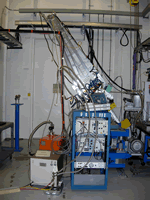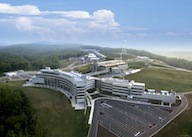Tools
X-ray Scattering
 Since the discovery of x-rays by Röntgen more than 100 years ago, x-ray diffraction has been one of the most important scientific tools for elucidating crystal structure of materials. This is evident in more than a dozen Nobel prizes awarded to the works using x-rays. Over the past three decades, synchrotron based x-ray sources have revolutionized the field of x-ray spectroscopy and diffraction, due to the tunability and high brightness of such sources. We carry out our x-ray scattering experiments at the synchrotron facilities listed here.
Since the discovery of x-rays by Röntgen more than 100 years ago, x-ray diffraction has been one of the most important scientific tools for elucidating crystal structure of materials. This is evident in more than a dozen Nobel prizes awarded to the works using x-rays. Over the past three decades, synchrotron based x-ray sources have revolutionized the field of x-ray spectroscopy and diffraction, due to the tunability and high brightness of such sources. We carry out our x-ray scattering experiments at the synchrotron facilities listed here.- All things synchrotron: lightsources.org
- Advanced Photon Source at the Argonne National Laboratory, located outside of Chicago, U.S.
- National Synchrotron Light Source at the Brookhaven National Laboratory, located near New York, U. S.
- Canadian Light Source is located in Saskatoon, and will be available for experiments in the future.
- For a general introduction to synchrotrons and science, see this site provided by National Synchrotron Light Source.
Neutron Scattering
 It is widely recognized that neutron scattering is one of the most powerful microscopic probes of magnetism in condensed matter systems. In particular, its capability to study spin dynamics and critical fluctuations is unparalleled, making it an indispensable probe of quantum magnetism and unconventional superconductivity. Canada has had a distinguished history of leadership in neutron scattering at Chalk River Laboratory. We carry out our neutron scattering experiments at various facilities around the world. In particular, the new Spallation Neutron Source in Oak Ridge, Tennessee is the brightest neutron source in the world, and will provide unique scientific opportunities in the next 5-10 years. For more information, there is an excellent neutron scattering primer written by Roger Pynn.
It is widely recognized that neutron scattering is one of the most powerful microscopic probes of magnetism in condensed matter systems. In particular, its capability to study spin dynamics and critical fluctuations is unparalleled, making it an indispensable probe of quantum magnetism and unconventional superconductivity. Canada has had a distinguished history of leadership in neutron scattering at Chalk River Laboratory. We carry out our neutron scattering experiments at various facilities around the world. In particular, the new Spallation Neutron Source in Oak Ridge, Tennessee is the brightest neutron source in the world, and will provide unique scientific opportunities in the next 5-10 years. For more information, there is an excellent neutron scattering primer written by Roger Pynn.Crystal growth and characterization
 Materials synthesis is an important aspect of our research. We would like to grow large high-quality single crystals for our neutron scattering experiments. Also, we carry out exploratory investigation to search for materials with novel properties, such as superconductivity and highly efficient thermoelectrics. We have a full suite of materials synthesis facilities including many tube and box furnaces. We also have a high-pressure gas environment furnace for oxide materials annealing. We have an optical image furnace for floating-zone crystal growth.
Materials synthesis is an important aspect of our research. We would like to grow large high-quality single crystals for our neutron scattering experiments. Also, we carry out exploratory investigation to search for materials with novel properties, such as superconductivity and highly efficient thermoelectrics. We have a full suite of materials synthesis facilities including many tube and box furnaces. We also have a high-pressure gas environment furnace for oxide materials annealing. We have an optical image furnace for floating-zone crystal growth.Our in-house characterization facility allows us to obtain valuable information about the samples we prepared, and also to gain preliminary knowledge about the system before our x-ray and neutron experiments. We have Quantum Design MPMS and PPMS (14T) systems, as well as a Huber 4-circle x-ray diffractometer with SPEC control software.


